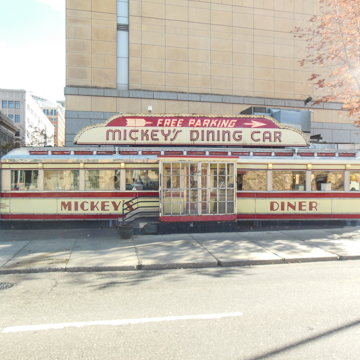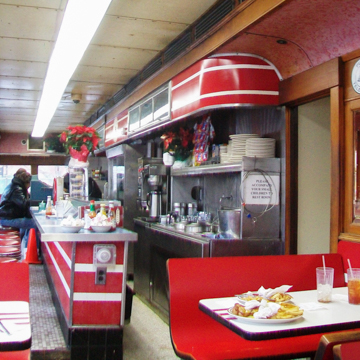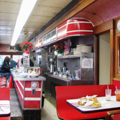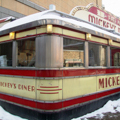Located in downtown St. Paul, Mickey’s Diner is a rare Upper Midwest example of a Streamlined Moderne free-standing diner of the type more typical of the northeast states of New York, New Jersey, and Pennsylvania. Indeed, the prefabricated Mickey’s Diner was manufactured by the Jerry O’Mahony Diner Company of New Jersey and shipped to St. Paul by rail in 1939. It has remained in its original location and has been in operation since it opened that year.
Mickey’s is a one-story rectangular building modeled after a railroad dining car with a symmetrical facade and centrally located entrance. The exterior features yellow and red porcelain steel panels, and horizontal windows divided by fluted chrome bands. “Mickey’s Diner” is painted in Art Deco style lettering similar to the Broadway typeface on the lower panels on each side of the main entrance. The monitor-style roof features a projecting rooftop sign with “Mickey’s Dining Car” in green neon. Above it, visitors are directed to “Free Parking” in red neon with an arrow pointing to the parking lot.
A glass-paned entrance vestibule was added to the diner sometime after its arrival in Minnesota. The interior is well-preserved and retains its historic ambiance; ten stools are located along a counter that faces the sunburst-patterned stainless steel back wall. In classic diner style, customers face the grills, deep-fryers, malt machine, refrigeration, and other equipment, above which a menu board is located. Freestanding laminate booths are located to the north/northeast of the counter seating.
After attending a National Restaurant Convention in Chicago in the late 1930s, original owners Mickey Crimmons and Bert Mattson decided to purchase a diner manufactured by the O’Mahony Dining Car Company (commonly referred to as Mahony) of Elizabeth, New Jersey. The company began manufacturing diners in 1913 and by the late 1920s had the industry's largest plant, capable of producing a diner a day. New Jersey was the epicenter of diner manufacturing in the first half of the twentieth century, home to companies such as the Kullman Dining Car Company, Paramount, and Federo. After producing approximately 2,000 diners, the O’Mahony operation closed in 1956 as the overall diner industry declined.
Although it was not yet 50 years old at the time of its designation, Mickey’s Diner was listed on the National Register of Historic Places in 1983 because of its significance as a classic New Jersey diner virtually intact in Minnesota. Mickey’s is also significant as a third-generation family business that has remained open 24 hours a day, 365 days a year since its opening more 70 years ago.
References
Butko, Brian, and Patrick, Kevin. Diners of Pennsylvania.Mechanicsburg, PA: Stackpole Books, 1999.
Murphy, Patricia, “Mickey's Diner,” Ramsey County, Minnesota. National Register of Historic Places Inventory-Nomination Form, 1982. National Park Service, U.S. Department of the Interior, Washington, DC.
Patrick, Kevin. “North Jersey Diner Tour and More: Soprano-land Diners.” Road News. Society for Commercial Archeology23, no. 3 (Fall 2015).



















